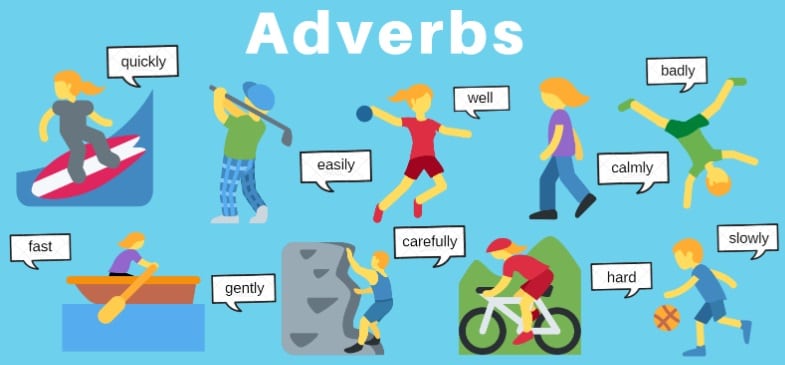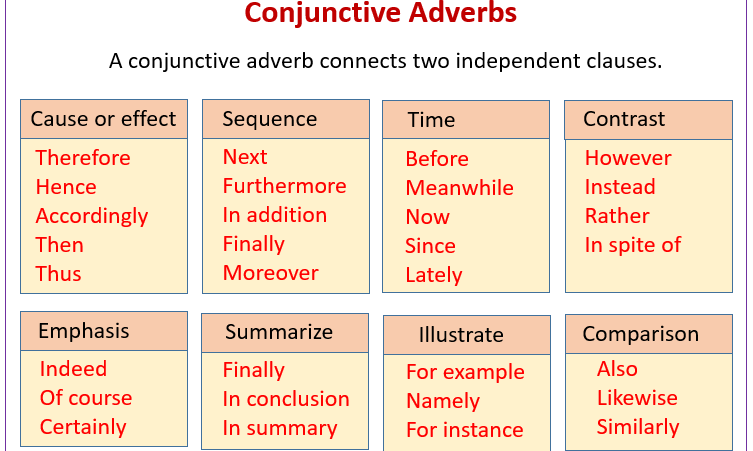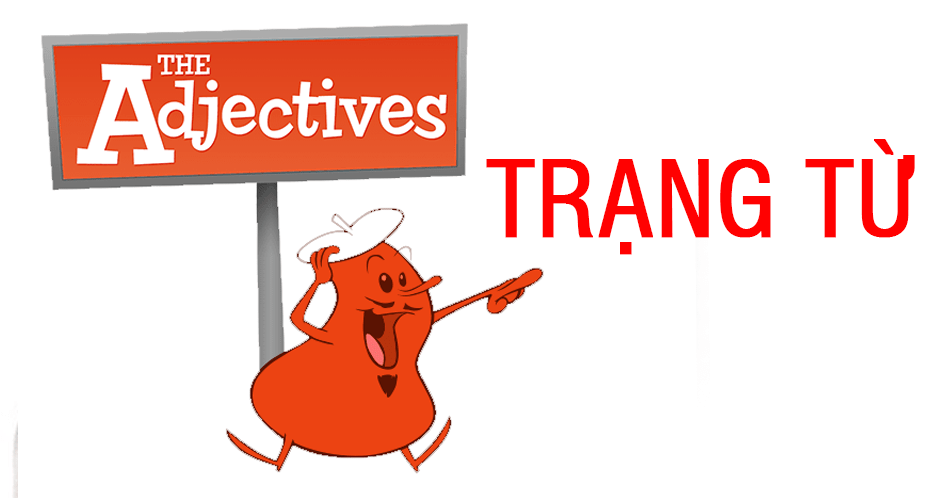Trạng từ – Adverb là gì? Đây là từ loại quan trọng bổ nghĩa cho các động từ, tính từ hoặc cả câu. Với sự hỗ trợ của trạng từ, câu mang một nghĩa khác và cụ thể hơn. Nhưng, mỗi động từ, tính từ sẽ đi kèm cùng với một loại trạng từ riêng. Bài viết Adverb Key bên dưới sẽ giúp các bạn hiểu rõ hơn về chủ điểm ngữ pháp này nhé!
Nội dung chính:
1. Adverb – Trạng từ là gì?
Cho ví dụ sau đây, liệu các bạn có thể ngay lập tức tìm thấy lỗi sai trong hai câu này?
- This hardly won liberty cannot be lightly abandoned
- It was bitter cold
Hai câu trên đều gặp lỗi sai với cách dùng “trạng từ” và cách thành lập “trạng từ”. hardly (hầu như không, hiếm khi)- hard (khó khăn), bitter (adj)- bitterly (adv).

Như các bạn thấy, trạng từ trong tiếng Anh không phải dễ học nếu không có kiến thức tổng hợp đầy đủ, đặc biệt, dùng thế nào trong IELTS cho hợp lý thì lại là vấn đề khác. Chúng ta hãy cùng tìm hiểu rõ trạng từ trong tiếng Anh và ứng dụng chi tiết nhé.
Adverbs- trạng từ hay còn gọi là phó từ, là những từ được sử dụng trong câu để bổ nghĩa cho động từ, tính từ, một trạng từ khác.
Example:
- Bổ nghĩa cho động từ: Can you move it carefully? it’s fragile. (Bạn có thể di chuyển nó cẩn thận chút được không. Nó rất dễ vỡ)
- Bổ nghĩa cho tính từ: The place was strangely quiet. (Nơi đây yên ắng đến lạ lùng)
- Bổ nghĩa cho trạng từ khác: We’ll meet shortly afterward. (Sau này chúng ta sẽ gặp nhau ít hơn).
2. Các loại trạng từ trong tiếng Anh
Theo chức năng, trạng từ được chia thành 7 loại chính như sau:
2.1. Trạng từ chỉ cách thức
Đây là loại trạng từ rất phổ biến trong tiếng Anh. Trạng từ cách thức được hình thành bằng cách thêm đuôi “ly” đằng sau tính từ.
Ví dụ: Exclusive – Exclusively; Recent – Recently; Beautiful – Beautifully,…
Cách dùng: Diễn tả cách thức hành động xảy ra như thế nào.
Vị trí: giữa hoặc cuối câu, nếu đứng giữa câu, trạng từ chỉ cách thức thường đứng sau động từ hoặc sau tân ngữ.
Ví dụ: He can speak French fluently.
Tuy nhiên có một số trường hợp ngoại lệ:
| Tính từ | Trạng từ |
| fast | fast |
| hard | hard |
| late | late |
| good | well |
| fair | fair |
| cheap | cheap |
| early | early |
| much | much |
| little | little |
2.2. Trạng từ chỉ thời gian

Trạng từ thời gian là những trạng từ thường trả lời cho câu hỏi “When”, chỉ thời gian xảy ra hành động.
Ví dụ: yesterday, tomorrow, next year,…
Cách dùng: Diễn tả thời gian, sự việc xảy ra hay được thực hiện, hành động,… .
Vị trí: Thường đứng cuối câu hoặc đầu câu để nhấn mạnh thời gian xảy ra.
Ví dụ: Yesterday, they dropped in my house but I couldn’t remember who they are.
2.3. Trạng từ chỉ tần suất
| Trạng từ tần suất | Nghĩa |
| Always | Luôn luôn |
| Usually | Thường xuyên |
| NormallyGenerally | Thông thường |
| Often | Thường thường |
| Sometimes | Thỉnh thoảng |
| Hardly | Hầu như không bao giờ |
| Rarely | Hiếm khi |
| Never | Không bao giờ |
Cách dùng Trạng từ tần suất: Diễn tả, thể hiện mức độ của chất lượng, sự việc, sự vật, trạng thái, điều kiện, mối quan hệ, …
Vị trí: Thường đứng giữa câu.
Ví dụ: The building was completely destroyed after the earthquake.
2.4. Trạng từ chỉ nơi chốn
Trạng từ chỉ nơi chốn dùng để trả lời cho câu hỏi “Where”.
Ví dụ: here, there, out, away, everywhere, below, along, around, away,…
Cách dùng: diễn tả nơi mà sự vật, sự việc nào đó xảy ra hoặc ở đâu.
Vị trí: Thường được đặt ở giữa câu, ngay sau động từ chính hoặc sau mệnh đề mà nó bổ nghĩa cho.
Ví dụ: Let’s open the box and see what’s inside it/ She goes everywhere with her husband.
2.5. Adverbs of Degree
Một số trạng từ thông dụng: quite, too, enormously, almost, just, completely, enough, deeply, virtually, fully, greatly, hardly, terribly, fairly, entirely, practically,… .
Cách dùng: Diễn tả, thể hiện mức độ của chất lượng, sự việc, sự vật, trạng thái, điều kiện, mối quan hệ, … .
Vị trí: Thường đứng giữa câu.
Ví dụ: The building was completely destroyed after the earthquake.
2.6. Adverbs of Evaluation – Trạng từ đánh giá, ước lượng
Một số Adverb Key thông dụng: absolutely, definitely, apparently, clearly, honestly, fortunately, unfortunately, frankly, bravely, carelessly, hopefully, …. .
Cách dùng: Dùng để đánh ra, nhận xét, đưa ra quan điểm về một sự việc nào đó, trạng từ ước lượng, đánh giá thường bổ nghĩa cho cả mệnh đề hoặc câu.
Vị trí: Thường đứng đầu hoặc giữa câu.
Ví dụ: Fortunately, they escaped from the fire.
2.7. Conjunctive adverbs (Linking adverbs)- Trạng từ nối

Một số trạng từ thông dụng: besides, moreover, however, indeed, meanwhile, consequently, furthermore, otherwise, therefore, likewise, thus, additionally, comparatively, finally, next, hence, accordingly,… .
Cách dùng: Có chức năng như liên từ, nối hai mệnh đề hoặc câu.
Vị trí: Thường ở đầu câu để liên kết hai câu với nhau hoặc ở giữa câu để liên kết hai mệnh đề.
Ví dụ: The government went through the decision of destroying historic buildings. Consequently, there aren’t any places of interest here.
3. Vị trí của trạng từ trong câu
3.1. Vị trí đầu câu
- Trạng từ liên kết
VD: (Task 1) US adolescents prefers cars but their preference for motorbikes is higher than that of the UK. However, less percentage of American youngsters prefers riding bicycles, only one out of ten.
- Trạng từ thời gian
VD: We decided to eat something in the hotel’s restaurant. Then we headed out to the beach
3.2. Vị trí giữa câu
Trạng từ có thể ở vị trí giữa câu, trước động từ chính. Nếu động từ chính là “be” thì trạng từ sẽ ở sau động từ. Và trạng từ đứng sau trợ động từ đầu tiên khi có nhiều hơn một trợ động từ.
- Trạng từ tần suất
VD: (Speaking)
Q. Have you ever been in very cold weather?
A: Well, I have to say I have never been in very cold weather
- Trạng từ cách thức
VD: (Task 1) Overall, the market for robotics will significantly progress in the coming years.
3.3. Vị trí cuối câu
- Trạng từ cách thức
VD: (Task 1) As is obvious, the internet subscribers in Vietnam increased steadily.
- Trạng từ chỉ nơi chốn
VD: My parents met by chance in Paris.
- Trạng từ chỉ thời gian
VD: It rained quite heavily yesterday.
4. Cách thành lập trạng từ trong tiếng Anh
Cách thành lập trạng từ số 1
Hầu hết các trạng từ đều được cấu tạo từ tính từ thêm “-ly”
Ví dụ: slow- slowly, enormous- enormously, clear- clearly, careful- carefully, annual- annually, hopeful- hopefully, additional- additionally, honest- honestly, … .
Trong một số trường hợp, những từ kết thúc bằng “-ble”, chúng ta thường bỏ “e” trước khi thêm “-ly’.
Ví dụ: true- truly, sensible- sensibly, remarkable- remarkably, horrible- horribly, … .
Nếu tính từ kết thúc là “-y), chúng ta chuyển thành “-” trước khi them “-ly”, trừ một số từ có một âm tiết và kết thúc bằng “-y” như sly, dry,…
Ví dụ: happy- happily, greedy- greedily, sly- slyly, easy- easily, … .
Cách thành lập trạng từ số 2
Một số trạng từ có “-ly” nhưng có thể là tính từ và một số trạng từ có cấu tạo giống như tính từ, do đó có thể khó để tìm và nhận biết trạng từ. Quy tắc dễ nhất là nhìn vào những từ khác đi kèm.
Nếu đứng trước một danh từ, nó có thể là tính từ:
Ví dụ: a early lecture, a late meeting, a short way, a …
Nếu có mối liên hệ đến động từ hoặc đi trước tính từ, nó có thể là trạng từ:

Ví dụ:
- environmental friendly
- The lesson was cut short.
- We met late at night.
- She came in early.
Giống như tính từ, trạng từ cũng có dạng so sánh.
Ví dụ:
- George walked the most slowly of all of them.
- The bar chart shows the girls performed the best at maths last year.
Cách thành lập trạng từ số 3
Trạng từ hình thành từ danh từ. Một số ít trạng từ được cấu thành từ danh từ với hậu tố “-wise”, có nghĩa là bằng cách nào, theo cách nào.
Ví dụ: sideways, clockwise, lengthwise, edgewise, crosswise, … .
He hit the tennis ball sideways. “in a way that sent it off to the side of the court”. ( Anh ấy đánh quá bóng tennis sang một bên.- Bằng cách nào đó anh ấy đã đánh quả bóng sang bên lề của sân tennis).
Trong một số trường hợp, trạng từ kết thúc là “-wise” bổ nghĩa cho ý kiến của mệnh đề và nó giới hạn quan điểm của người nói về một ý kiến, phạm vi của chủ đề.
Ví dụ: otherwise, timewise, likewise,… .
It can’t be too windy. Otherwise, the officials postpone the match. Likewise, heavy rain can be a reason for postponing this match.
Những trường hợp đặc biệt
| Những trạng từ có hình thức không phổ biến | Chuyển nghĩa |
| Với trường hợp này, cấu tạo của tính từ và trạng từ giống nhau hoặc đều kết thúc bằng “-ly” | Trạng từ được cấu tạo từ tính từ có thể có nghĩa khác hoàn toàn với nghĩa của tính từ ban đầu. |
| – daily- daily The magazine is published daily. (adv) This is the daily edition of the magazine.( adj) – early- early It is the early edition of the magazine (adj). The magazine arrives early. (adv) – fast- fast She is a fast runner. (adj) She runs fast. (adv) – hard- hard Tt was a hard problem. (Adj) They play hard. (adv)…………. | – hard (tough- cứng)- hardly ( barely- hiếm khi) A desk has a hard surface. (adj) I hardly have time to hang out with friends. (adv) – late (tardy- muộn, trễ)- lately (recently- gần đây, mới đây) He arrived late to the office. (adj) He hasn’t been working lately. (adv) – Free (no cost- miễn phí)- freely (without restriction- tự do) Water is free. (adj) You can speak freely. (adv) – pretty (beautiful- đẹp)- pretty (rather- hơn) She is a pretty child. (adj) She is pretty difficult to control. (adv) |
5. Lỗi sai hay mắc ở trạng từ
Các bạn học tiếng Anh thường sử dụng sai tính từ và trạng từ, đặc biệt là Task 1 miêu tả xu hướng tăng giảm.
Ví dụ:
The price of coffee rose significantly in 1995 = There was a significant rise in the price of coffee in 1995.
Trong câu trên, “significantly” là trạng từ bổ nghĩa cho động từ quá khứ “rose”, còn “significant” là tính từ bổ nghĩa cho danh từ “rise”.
Nếu bạn muốn bổ nghĩa cho danh từ hoặc đại danh từ, bạn sử dụng tính từ. Còn dùng trạng từ nếu bổ nghĩa cho những loại từ khác.
6. Bài tập về Adverb Key
Bài tập
Bài 1: Hoàn thành Task 1 IELTS Writing dưới đây
The line graph shows the percentages of American men and women who remained unmarried. The statistical data is presented from 1990 to 2010 and it (clear) indicates that the proportion of such Americans (gradual) increased over the period and unmarried men’s ratio was higher than that of women.
According to the illustration, more than one quarter adult males and one-fifth females were unmarried in 1990. This proportion (slight) increased in the next decade when more than 25% male and 21% female were unmarried. The proportion of this single men and women in next five years rose at a higher pace. Afterwards, the unmarried population in the USA surged more (rapid). Between 2008 and 2010 the ratio (significant) increased. After 2008, around 30% US males remained unmarried while the proportion of unmarried females was slightly less than that, (rough) 24%.
In summary, unmarried adult males’ ratio in America was higher than that of females and not marrying is a trend that accelerated (noticeable) faster from 2008 to 2010.
Bài 2: Cho dạng đúng của từ trong ngoặc
1. He………….reads a book. (quick)
2. Mandy is a………….girl. (pretty)
3. The class is………….loud today. (terrible)
4. Max is a………….student. (good)
5. You can………….open this tin. (easy)
6. It’s a………….day today. (terrible)
7. She sang the song……. (good)
8. He is a………….driver. (care)
9. He drives the car……(careful)
10. The dog barks……(loud)
Bài 3: Complete the following sentences with adjective or adverb form of the words
1. Tina listened to her mother…………. ( careful)
2. Moana was ……………… hurt in a car accident. (serious)

3. She is very ………………. and earns a lot of money. (success)
4. He becomes …………………… when he sees her. (happy)
5. The car goes extremely ……………….. . (fast)
6. He is not a good student, but he writes ………. (good).
7. He is tired because he has worked ……………. .(hard)
8. We’ll have an accident if you don’t drive more ……………….. (careful).
9. She looked ………… , but I’m not sure she was feeling very nervous. (calm)
10. Tom is ………… . He works …………………… (slow)
Bài 4: Cho dạng đúng của từ trong ngoặc. Dạng đó có thể là tính từ hoặc trạng từ.
1. Once upon a time there were three little pigs who wanted to see the world. When they left home, their mum gave them some advice: Whatever you do, do it the (good)…………. you can.
2. So the three pigs wandered through the world and were the (happy)…………. pigs you’ve ever seen.
3. They were playing (fun)…………. games all summer long, but then came autumn and each pig wanted to build a house.
4. The first pig was not only the (small)…………. but also the (lazy)…………. of the pigs.
5. He (quick)…………. built a house out of straw.
6. The second pig made his house out of wood which was a bit (difficult)…………. than building a straw house.
7. The third pig followed his mum’s advice and built a strong house out of bricks, which was the (difficult)………….house to build.
8. The pig worked very (hard)…………., but finally got his house ready before winter.
9. During the cold winter months, the three little pigs lived an (extreme)…………. happy life in their houses.
10. They (regular)…………. visited one another and had the (wonderful)…………. time of their lives.
BÀi 5: Choose the best answers
James, a golfer, was playing a round golf yesterday when he (accidental–accidentally) hit his ball into a hole off the golfing greens. James made an (accidental–accidentally) shot. Unexpectedly, an (angry–angrily) gopher appeared. The gopher (angry–angrily) pushed the ball out out of its hole. The gopher complained (loud–loudly). The gopher made a (loud–loudly) complaint. The ball hit him (hard–hardly) on the head. James could (hard–hardly)believe that a gopher was making its home on the golf course. Normally, James has (good–well)eyesight. However, he didn’t see (good–well) this time because his ball did land anywhere near the golf green.
The gopher probably had a (painful–painfully) headache. The gopher lay still for a moment and then blinked its eyes (painful–painfully). The (guilty–guiltily) golfer, James, reached for his ball. “Sorry, little guy!” James said (guilty–guiltily). The gopher disappeared (quick–quickly) into its hole—with the ball! So James (quick–quickly) left the golfing green without his ball. After this experience, James (wise–wisely)wore his glasses whenever he played golf. The (wise–wisely) gopher found a new hole to live in.
Bài 6: Choose the best answer
1. I did really ………… in the mathematics test.
A. bad
B. badly
2. You were very ……….. to lose the game.
A. unlucky
B. unluckily
3. You should speak more …………..
A. soft
B. softly
4. I’ve never seen her dance so ………….
A. good
B. well
5. That milk tastes ……….
A. sour
B. sourly
6. This brown fur feels ………
A. soft
B. softly
7. The brave men fought……….
A. brave
B. bravely

8. The little boy looked …… . I went over to comfort him and he looked at me……
A. sad/ sad
B. sad/ sadly
9. I tasted the soup …….. but it tasted ……….
A. careful/ wonderfully
B. carefully/ wonderfully
C. carefully/ wonderful
D. careful/ wonderful
10. My mother speaks …… German
A. perfect
B. perfectly
Bài 7: Đoạn văn sau đây chứa 8 lỗi sai. Tìm và sửa chúng để tạo thành một bài IELTS Speaking Part 2 hoàn chỉnh
I would say that my relationship with him is as a friend. I know him because I regular go to the shop in order to buy things when I don’t have time to go to a supermarket. He’s quite friendlily and I always have a chat with him. I’ve known him now for about five years – since I’ve lived in the area in fact. That’s why I’d now call him a friend.
I’d say that I see him fair regularly. Like I said, I go to the big supermarket out of town some times to stock up, but you always need odd things during the week such as milk, or some snack or other. So when this happens I just have a walk down to his shop. So I’d say I see him every one or two days.
I think John is prettily popular as he’s been there for years as far as I’m aware, so most of the locals around the area know him. There will always be someone in the shop having a chat with him. They like him because he’s not just the shopkeeper but he’s also very involved in activities in the community. For example, I know he helps out at the old people’s home some nights, and he runs the quizzes at the local pub. He also helps to organize the fete that is held each year in the town.
The reason that I like him is that he’s greatly to have a chat with. For instance, a while back I was having problems with my work, and I was really feeling stressedly. I didn’t really have anyone to talk to at the time as my family is abroad and a couple of my good friends were not around. I mentioned it to John and he was great. He listened and also gave me some really good advice. He didn’t need to do that so it was great that he made the time to anyway. General, though, he’s really welcoming when you go to his shop. He’ll always have a smile on his face.
Đáp án
Bài 1
| 1. Clearly | 2. Gradually | 3. Slightly | 4. Rapidly | 5. Significantly | 6. Roughly | 7.Noticeably |
Bài 2
1. quickly
2. pretty
3. terribly
4. good
5. easily
6. terrible
7. well
8. careful
9. carefully
10. loudly
Bài 3
- carefully
- seriously
- successful
- happy
- fast
- well
- hard
- carefully
- calm
- slow/ slowly
Bài 4
1. best
2. happiest
3. funny
4. smallest, laziest
5. quickly
6. more difficult
7. most difficult
8. hard
9. extremely
10. regularly, wonderful
Bài 5
| 1. accidentally | 2. accidental | 3. angry | 4. angrily | 5. oud or loudly (both) |
| 6. loud | 7. hard (adj & adv have same form) | 8. hardly (“barely”, “almost not”) | 9. good | 10. well |
| 11. painful | 12. painfully | 13. guilty | 14. guiltily | 15. quickly |
| 16. quick | 17. wisely | 18. wise | 19. wisely | 20. wise |
Bài 6
| 1. B | 2. A | 3. B | 4. B | 5. A |
| 6. A | 7. B | 8. B | 9. C | 10. B |
Bài 7
1. regular => regularly
2. friendlily => friendly
3. fair => fairly
4. some times => sometimes
5. prettily => pretty
6. greatly => great
7. stressedly => stressed
8. general => generally
Duhoctms.edu.vn mong rằng những kiến thức về Adverb Key vừa chia sẻ ở trên sẽ giúp các bạn hiểu khái niệm và cách sử dụng trạng từ. Chúc các bạn học tập tốt và đạt được kết quả cao trong mọi kỳ thi!


Bình luận